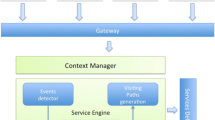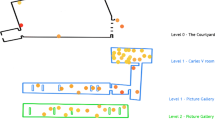Abstract
The ability to integrate, manage, and analyze large amounts of data extracted from different sources is becoming a key asset for businesses, organizations, and research institutions that deal with the cultural heritage domain. Nowadays, it is well known that modern technologies and the massive use of mobile devices can contribute to generate an enormous flow of data, whose collection, analysis, and interpretation allows for real-time analysis related to the behaviors, preferences, and opinions of users. In this paper, we present and discuss a data analytics approach relying on an Internet of Things framework. The main goal is to assess how the collection of behavioral IoT data coming from the cultural heritage domain can be opportunely exploited by means of data science and data analytics techniques in order to produce useful insights. Experimental results performed in a real case study demonstrate how the cultural heritage domain, and the related stakeholders, can benefit from these kind of applications.












Similar content being viewed by others
References
Melton AW (1935) Problems of installation in museums of art. American Association of Museums (New Series, No 14), pp 29–30
Bollo A (2016) Il monitoraggio e la valutazione dei pubblici dei musei. Gli Osservatori dei musei nellesperienza internazionale, Quaderni della Valorizzazione Nuova Serie, 2, Direzione Generale Valorizzazione-Mibact
Piccialli F, Yoshimura Y, Benedusi P, Ratti C, Cuomo S (2019) Lessons learned from longitudinal modeling of mobile-equipped visitors in a complex museum. Neural Comput Appl, 1–17. https://doi.org/10.1007/s00521-019-04099-8
Matthew Berland constructivist analytics: using data to enable deeper museum experiences for more visitors—lessons from the learning sciences, visitors studies, vol 20, pp 3–9 (2017)
Martella C, Miraglia A, Frost J, Cattani M, Steen M (2017) Visualizing, clustering, and predicting the behavior of museum visitors. Pervasive Mobile Comput 38:430–443
Hooper-Greenhill E (2006) Studying visitors. In: Macdonald S (ed) Companion to museum studies. Blackwell Publishing, Oxford, pp 362–376
Mygind L, Bentsen P (2017) Reviewing automated sensor-based visitor tracking studies: beyond traditional observational methods? Visitor Stud 20:202–217
Kanda T, Shiomi M, Perrin L, Nomura T, Ishiguro H, Hagita N (2007) Analysis of people trajectories with ubiquitous sensors in a science museum. In: Proceedings 2007 IEEE International conference on robotics and automation, pp 4846– 4853
Yoshimura Y, Sobolevsky S, Ratti C, Girardin F, Carrascal JP, Blat J, Sinatra R (2014) An analysis of visitors’ behavior in the louvre museum: a study using bluetooth data. Environ Planning B: Plan Des 41:1113–1131
Kirchberg V, Tröndle M (2015) The museum experience: mapping the experience of fine art. Curator: Museum J 58:169–193
Veron E, Levasseur M (1989) Ethnographie de l’exposition : l’espace, le corps et le sens Centres Georges Pompidou
Yalowitz SS, Bronnenkant K (2009) Timing and tracking: unlocking visitor behavior. Visit Stud 12(1):47–64
Dean D (1994) Museum exhibition theory and practice. London, Routledge ISBN 978- 020-3039-366
Serrel B (1996) Exhibit labels: an interpretive approach, vol xv. Alta Mira Press, Walnut Creek, p 261. ISBN 07-619-9106-9
Acknowledgments
This work was supported by the Cultural Equipment with Transmedial Recommendation Analytics - C.E.T.R.A. research project [Regione Campania - Bando RIS3 2018 - Fase 2]. We also thank to the High Technology District for Cultural Heritage - DATABENC (http://www.databenc.it) and Databooz Italia srl company for the support.
Author information
Authors and Affiliations
Corresponding author
Additional information
Publisher’s note
Springer Nature remains neutral with regard to jurisdictional claims in published maps and institutional affiliations.
Rights and permissions
About this article
Cite this article
Piccialli, F., Benedusi, P., Carratore, L. et al. An IoT data analytics approach for cultural heritage. Pers Ubiquit Comput 24, 429–436 (2020). https://doi.org/10.1007/s00779-019-01323-z
Received:
Accepted:
Published:
Issue Date:
DOI: https://doi.org/10.1007/s00779-019-01323-z




